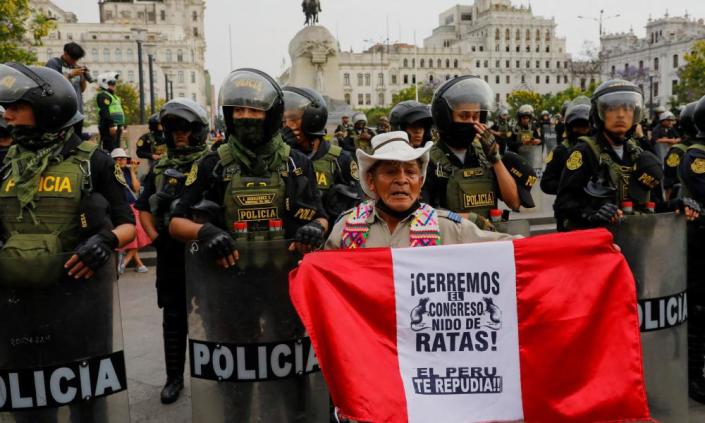What is happening in Peru?
Since former president Pedro Castillo was ousted last week, protests have broken out across the country, with demonstrators blocking roads and stalling the airport in Peru’s second-largest city, Arequipa. Airlines have cancelled flights there and to Cusco, Peru’s tourism capital.
Demonstrations erupted at the weekend in impoverished areas in southern Peru and have now spread to the north and east of the country amid widespread vandalism and looting, in which police stations, regional prosecutors’ and tax offices have been torched. At least seven protesters – five of them teenagers – have died from gunshot wounds in clashes with police, six of them in the southern city of Andahuaylas, which became a hub for the protests.
On Wednesday, December 14th, the government declared a 30-day state of emergency, suspending the right of assembly and free movement.
How did this start?
Castillo was forced out after he attempted to temporarily suspend congress in an effort to avoid impeachment for “moral incapacity” – a charge stemming from multiple corruption allegations. He announced he would rule by decree under emergency powers, and called for new legislative elections.
But in a matter of hours, Castillo’s illegal attempt to take over the country fell apart. His best ministers deserted him immediately, denouncing his coup and political allies, the armed forces, the police and even his lawyer followed suit.
Castillo attempted to seek asylum in the Mexican embassy but his own security detail diverted his car to a police station, where he was detained and later charged with “rebellion”.
Meanwhile, congress skipped the debate and moved straight to an impeachment, voting overwhelmingly to remove him.
Castillo’s vice-president, Dina Boluarte, was sworn in as his replacement, while the ousted leader was transferred to Barbadillo prison in a police base on the outskirts of Lima, also the home of another former president and coup-monger 84-year-old Alberto Fujimori.
Was it a coup?
Many Peruvians described Castillo’s move as an attempted autogolpe, roughly translated as self-coup. In 1992, Fujimori made a similar promise to “temporarily dissolve the congress” and the chamber was promptly surrounded by tanks as he assumed absolute power. He went on to arrest journalists and opposition leaders, censor newspapers and television stations, beginning an autocratic regime that would last for nearly a decade.
Castillo copied the same phrase but his autogolpe, by comparison, was a farce, prompting the political analyst Iván Lanegra, to comment “Pedro Castillo was dictator for only two hours”. For many, it was a fitting end to a disastrous 17-month term. The former schoolteacher churned through some 80 ministers and is dogged by accusations of corruption, with six ongoing investigations by the country’s attorney general. Constitutional experts say Castillo’s announcement was an illegal power grab, but the governments of Argentina, Bolivia, Colombia and Mexico have refused to recognise Boluarte as Peru’s legitimate head of state.
Why are people so angry?
Castillo’s own attempt to seize power did nothing to diminish the fury over his ousting which sent shockwaves through his strongholds in the rural Andes and poorer neighbourhoods in the capital. His supporters accuse the loathed congress of staging a coup against their leader, the son of illiterate peasant farmers, and the first member of the country’s impoverished rural poor to become president.
“There is a hunger to believe in Castillo,” said Omar Coronel, a sociology professor and Peru’s Pontifical Catholic University. “It is easier to believe in Castillo the prisoner, Castillo the martyr, than in Castillo surrounded by all kinds of accusations of corruption.”
What happens next?
The protests may eventually die down as resources run low, Christmas holidays approach and roadblocks drive up already inflated prices of basic goods like rice, cooking oil and wheat.
But the fundamental problems driving the unrest will not go away: an abysmal gap remains between the powerful capital, Lima, and much of the rest of the country which identified with Castillo and feels neglected by its institutions and, most of all, its hugely unpopular congress, which is largely viewed as a viper’s nest of corrupt lobbies and vested interests.
Boluarte may have selected some competent ministers but the political crisis is well past the challenges of day-to-day governance. The behind-doors scheming will continue and Boluarte herself could find herself on the sharp end of an impeachment vote.
Analysts have long talked about the Peruvian paradox – the coexistence of political instability and economic stability, but that may become a thing of the past. Peru’s broken political system will inevitably drive down foreign investment – which the economy is heavily reliant on – and the situation could get even worse.
TYT Newsroom


